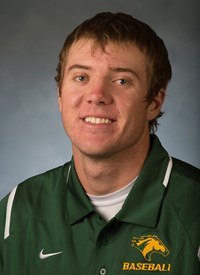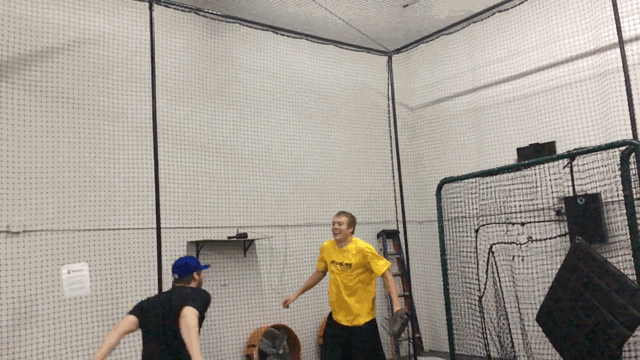Learning to Train With Intent: How Peter Bayer Got Drafted

The 9th-round pick of the Tampa Bay Rays is an unlikely signee. Because, at the end of 2015, Peter Bayer was not a prospect.
At the University of Richmond from 2013-2015, the 6’4″ 185-pound pitcher compiled a 7.86 ERA in 87 innings with non-premium velocity.
If you looked at my stats, you’d say I have no shot to be where I am today. But without those setbacks I don’t think I would have worked as hard to get better.
Training Begins: Trusting the Place in a Tiny Room
Like most athletes with a dream or a goal, Peter was no stranger to training. Since before college, he had been a hard worker. And he kept that work up in college.
He first came to Driveline in the summer of 2014 and had trained with weighted balls previously. Like many first time trainees, he was a little hesitant at first.
I have to thank my parents, especially my dad, for trusting that this place in a tiny room in the upstairs of a facility actually knew what they were talking about. But once I got there I realized that this place might change my life, which it did.
That summer he pulled down in the low 90s. His training videos from those days show an athlete who is familiar with the names and forms of different throwing drills, but hasn’t internalized them yet.
Pulling down 90 and showcasing some low-intent Pivot Pickoffs (Peter’s is the first throw)
There is a big difference between doing pivot pickoffs and doing pivot pickoffs as if your career depends on them. The intent level and focus on each rep is different.
In these videos, I am almost pushing the ball and have hardly any intent to throw a ball hard at all. I’d say the biggest difference is that now, I have intent to throw the ball hard every single time and my throwing motion and arm action looks so much more natural. I think the biggest improvements I made were intent, glove side clearance and simply just getting more athletic.
Returning a New Man
In 2014, Peter was still finding his way. But by 2015, he was training with his hair on fire. Returning to Driveline that summer, his improvements were readily apparent on Day 1.
His pulldown velocities had increased at least 6mph. He was no longer barely throwing 90 but routinely grabbing 95s and 96s. The improvements he noted on his videos were apparent.
The added strength had helped his front leg brace.
Training at high intent, he no longer worried that he wouldn’t decelerate his arm perfectly but just threw, trusting his training had prepared him.
The weighted ball work had transferred to the mound. In bullpens, he was now sitting 90 MPH of the mound and, having learned how critical his training environment was, looking for a new school.
The role of the environment is huge. The best part about Driveline, in my opinion, is seeing all of the people you are training with, knowing how much better some of them are than you, and realizing how much harder you have to work to get to that point.
When you surround yourself with a bunch of people who are constantly pushing themselves to get better, it instills in you a work ethic that cannot be matched by anything else.
From the recruiting video above, Peter left and showcased a fastball at 89-92 MPH the California Collegiate League, with a 13.8 K/9. He signed in the summer of 2015 with Cal Poly Pomona.
Check from ball release to maximum deceleration in @PeterBayer47‘s mechanics. What do you see? #videoworth1000words pic.twitter.com/G45Iv6KGLC
— Kyle Boddy (@drivelinebases) May 25, 2015
Unsatisfied: Training after Signing
If the point of training is to sign, you can quit after you’ve signed. But Peter kept pushing for something more.
Cal Poly Pomona happened to be the place to take me in and the rest is history. That summer, and this school year, I worked harder than I ever have in my life to get to where I got, which meant sacrificing tons of time into training and putting almost everything else behind me.
Many pitchers work their entire careers to be able to say “I throw 90.” With the end of a college career in sight and a scholarship in hand for possibly the last year of their career, many guys would be content with what they had achieved.
Four years of playing time in college and all the memories and experiences that affords, that’s more than most of the kids on your little league team growing up can say.
Even at 6’4″, a right-handed college senior throwing 88-90 MPH with Peter’s track record likely doesn’t have a spot at the next level.
But, by continuing to work when it might seem like Peter had it made, he built upon a good summer and created his eventual draft success.
If you want to throw 90 and think that’s the key to success and a pro career, it isn’t. You have to keep learning. You have to keep developing.
It is awesome that Driveline constantly is making improvements, and learning new things. Every single time I go back, I learn way more information than the previous time. It also has to deal with training with people who are on the same mission as you.
A video posted by Peter Bayer (@peterbayer) on
Just a few months after signing to Cal Poly, Peter came back again to Driveline massively improved.
He threw a baseball 100 MPH.
One reason @PeterBayer47 is so nasty: 90-94 MPH FB that spins at 200+ RPM the MLB avg for a 92 MPH FB. #mlbdraft l pic.twitter.com/dGHSkA7cDa
— Kyle Boddy (@drivelinebases) February 25, 2016
He showcased a fastball with plus spin.
He was just ready.
Competition
And he threw with confidence for Cal Poly.
I knew I was throwing way harder, but I did not realize how hard I was throwing until my first outing I had this year in February. I came out of relief, threw 3.1 IP with 9Ks, no hits, 1 walk, no runs… and then found out I was sitting 93-95.. I definitely knew after that game that I could do this and achieve my dreams as long as I kept pushing myself to get better.
He did. He finished with a season line to be proud of (103K in 65.2 IP) and had a dominating start in the D2 World Series throwing a 1-hit, 8-inning gem with 14 Ks.
And, on June 9th, he realized a life long dream.
9 (270): @RaysBaseball select Cal Poly Pomona RHP Peter Bayer. https://t.co/8ZkHvHbPAZ#MLBDraft
— MLB Draft Tracker (@MLBDraftTracker) June 10, 2016
But he isn’t done working.
The fact that you see everyone around you who is better than you, or people that you can learn something from. In the offseasons to come, I will be coming out because there really is not a better place where you can better yourself.
I think a lot of people might say, or at least based on what they ask and tell me is that Driveline is a magic formula, or a place where you can just go and learn the information and all of the sudden you are going to gain way more velocity… but this could not be more false.
It takes an insane dedication to working, training and doing the right things and I believe that is what Driveline provides you with more than anything.
Want to learn more about strength training as it relates to being a better pitcher? Read all of our articles relating to strength here.
Want to learn more about what we know about gaining fastball velocity? Check out the wide array of blog articles we have relating to velocity building here.



Comment section